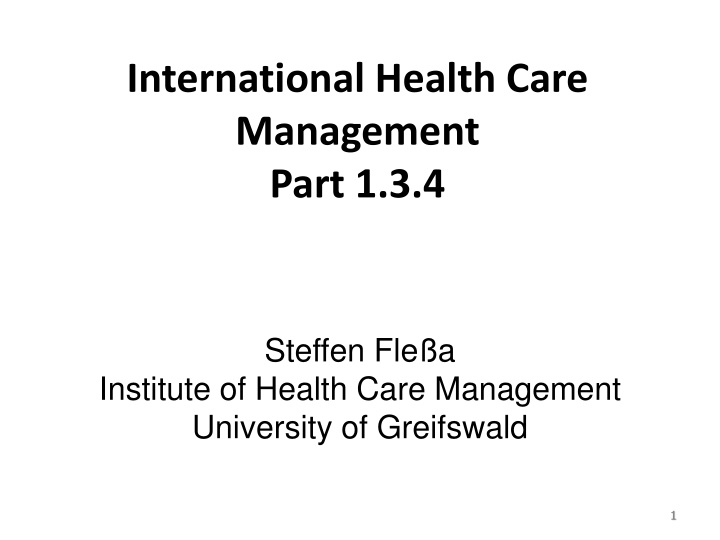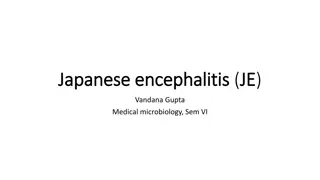
International Health Care Management and Development Insights
Explore key concepts in international health care management, recent developments in the World Development Report 1993, Millennium Development Goals, and the Commission on Macroeconomics and Health. Discover the significance of health investments, achieving sustainable development goals, and the impact on global partnerships.
Download Presentation

Please find below an Image/Link to download the presentation.
The content on the website is provided AS IS for your information and personal use only. It may not be sold, licensed, or shared on other websites without obtaining consent from the author. If you encounter any issues during the download, it is possible that the publisher has removed the file from their server.
You are allowed to download the files provided on this website for personal or commercial use, subject to the condition that they are used lawfully. All files are the property of their respective owners.
The content on the website is provided AS IS for your information and personal use only. It may not be sold, licensed, or shared on other websites without obtaining consent from the author.
E N D
Presentation Transcript
International Health Care Management Part 1.3.4 Steffen Fle a Institute of Health Care Management University of Greifswald 1
1.3 Concepts 1 International Public Health 1.1 Background 1.2 Health and Development 1.3 Concepts 1.3.1 Prevention 1.3.2 Primary Health Care 1.3.3 Health Promotion 1.3.4 Recent Developments 2
1.3.4 Recent Developments World Development Report 1993 Annual World Development Reports of World Bank on changing topics Predecessor: Financing Health Care Services in Developing Countries An Agenda for Reform (World Bank 1987) 1993: Investing in Health Content: defined orientation on efficient measures of intervention Measuring efficiency using DALYs 12 US$ for the provision of basic supply in LLDCs (33 % on prevention, 67 % on curation) Follow-up document: Better health for Africa (1994) 3
Millennium Development Goals 1. Eradicate extreme poverty and hunger until 2015 2. Achieve universal primary education 3. Promote gender equality and empower women 4. Reduce child mortality 5. Improve maternal health 6. Combat HIV/Aids, Malaria and other diseases 7. Ensure environmental sustainability 8. Global partnership for development 4
Commission on Macroeconomics and Health Commission on Macroeconomics and Health Gro Harlem Brundtland in January 2000 Report: December 2001 Members: Jeffrey Sachs, Robert Feachem et al. Goal: Identify ways on how to reach the Millennium Development Goals 5
Results I Health as the central factor of production Investments in health are rational Better health does not lead to an increase in birth rates Better health has a higher rate of return than numerous other investments Investments in health allow overcoming development traps! 6
Results II The expenditure on health per capita and year have to be increased to 30-40 US$ Donor organizations have to cover the difference to the current expenditure equaling 30 US$ per capita and year or 27 billion US$ respectively Donor organizations have to quintuple their current investments in health (from 5 to 27 billion p.a.) 7
Realistic? Investment (annual): 27 billion, thereof 22 billion additionally??? absolutely unrealistic! But: even small investments pay off Example: fight against Malaria, AIDS, TB 8
Global Fund Global Fund to Fight AIDS, Tuberculosis and Malaria GF founded in June 2001 by the UN General Assembly (Kofi Annan) GF represents an instrument of financing not an agency for implementation Goal: 10 billion US$ p.a. Reality: ??? 9
Declaration of Paris 28/2-2/3/2005: conference of donor and partner countries Goal: Increasing the efficacy in development cooperation, inter alia by means of a binding agreement on indicators for progress https://www.oecd.org/dac/effectiveness/parisdeclarationandaccraagendaforaction.htm 10
Principles of Paris for sustainable development Reinforcing the Ownership of partnering countries, Alignment of developmental cooperation on national developmental strategies, institutions and procedures, Harmonization of donor activities, Introduction of Managing for Results and Mutual Accountability. 11
Managing for Results: Examples Examples for Indicators Increase the number of partnering countries that can prove developmental strategies Increase the percentage of financial benefits being paid according to an agreed schedule Increase the percentage of financial benefits being paid within program based approaches 12
Declaration of Paris Implementation (Examples) Sector Wide Approach (SWAp) Basket Funding Output Based Aid Elite-Training (ILT) Problem: Return to elites The problem being the legitimation of elites by the civil society http://www.betteraid.org/ 13
Consequence of Paris Providing for Health (P4H) (2007) P4H is aiming in particular to address the incapacity of poor people living in low- and middle-income countries to access quality health services. Initiative von development EZ- and UN- Organisations (e.g. WHO, WB, DiFID, GIZ, KfW) Focus: Social Security http://www.who.int/providingforhealth/about/en / 14
Consequence of Paris International Health Partnership (2012) Broadly distributed (WHO, European Commission, WB, UNAIDS, UNFPA, GAVI Alliance, UNICEF, Bill and Melinda Gates Foundation, African Development Bank, GFATM, UN Development Group) goals (not only social security): More inclusive national health planning and joint assessment (JANS) processes More unified support to national plans through country compacts One monitoring and evaluation platform to track strategy implementation Greater mutual accountability Improved civil society engagement Harmonized financial management http://www.internationalhealthpartnership.net/en/ 15
Accra Agenda for Action (AAA, 2008) Target: Strengthen and deepen implementation of the Paris Declaration, AAA takes stock of progress and sets the agenda for accelerated advancement towards the Paris targets Improvement fields: Ownership: Countries have more say over their development processes through wider participation in development policy formulation, stronger leadership on aid co-ordination and more use of country systems for aid delivery Inclusive partnerships: All partners (Governments, donors, foundations and civil society) participate fully Delivering results: Aid is focused on real and measurable impact on development. Capacity development: ability of countries to manage their own future 16
DAC Criteria Term: DAC Criteria for Evaluating Development Assistance OECD: Organisation for Economic Co-operation and Development DAC: Development Assistance Committee Criteria to assess development assistance: Relevance: Are we doing the right thing? Effectiveness: Will we achieve the project's objective? Impact: Are we contributing to the achievement of overarching development results? Efficiency: Are the objectives being achieved cost-effectively? Sustainability: Are the positive results durable? 17
Business of Health International Finance Corporation, The World Bank Group (2008): The business of health in Africa Content: Investments in the African health care demand for the private sector Public-Private-Partnership Private not for the rich only! 18
Universal Health Coverage WHO (homepage 2013) Universal coverage (UC), or universal health coverage (UHC), is defined as ensuring that all people can use the promotive, preventive, curative, rehabilitative and palliative health services they need, of sufficient quality to be effective, while also ensuring that the use of these services does not expose the user to financial hardship. 19
UHC Evans, Hsu & Boerma (2013) Universal health coverage is the obtainment of good health services de facto without fear of financial hardship. Kutzin (2013) UHC is system-wide effective coverage combined with universal financial protection. 20
Elements of UHC Health WHO Constitution 1948 Health is a state of complete physical, mental and social well- beingand not merely the absence of disease or infirmity . Alma Ata 1978: Health for All by the Year 2000 Health For All means that health is to be brought within reach of everyone in a given country. And by "health" is meant a personal state of well being, not just the availability of health services . (H. Mahler 1981) UHC is not a reprint of Health for All Strong emphasis on health care delivery and social security Clearly more realistic 21
Elements of UHC Coverage Accessibility Physical accessibility Financial accessibility Acceptance Willingness of the population to accept the provided services Problem: social and cultural barriers Effective Health Services Quantity of health services Quality of health services Broadness and depth of provided health services 22
Elements of UHC Universal 1. Who is covered? Poverty groups? Almost-poor in the informal sector? Almost-poor in formal sector? Middle class? Rich? Urbane and rural population? Employees, unemployed, informal sector, families? 23
Elements of UHC Universal 1. 2. What services are covered? Health promotion, prevention, out-patient, in-patient, rehabilitation, palliative care? Communicable diseases, chronic degenerative diseases, ? Interventions low in cost or resource intensive (i.e. ART and HAART? Dialysis?) 3. Which proportion of costs is covered? Public health expenditures, health insurance, Out-of-Pocket? 24
Dimensions of UHC Reduce cost sharing and fees Direct costs: proportion of the costs covered Include other services Extend to non-covered Services: which services are covered? Population: who is covered? Quelle: WHO 2011 25
Universal Health Coverage Worldwide http://what-is-is.blogspot.de/2012/09/lancet-how-to-achieve-universal-health.html Die verlorene Mitte - 10 Jahre HCM
UHC and Economic Framework DEMAND-SIDE SUPPLY-SIDE Demography Epidemiology Transition Contacts Risk of admission Length of stay Disease Pattern SCARCITY Staffing Equipment Buildings Location AGENTS Emergencies, accidents Seasonality Prevention M a n a g e m e n t Health Education NEEDS Population density ExcessCapacity Time per Service Unit PRODUCTION Distance Barriers Transport time/distance Infrastructure Mental mobility Attraction Cultural / natural barriers Type of medicine Input-Based Output-Based WANT Financial System Daily Rate Flat Rate Fee-for-Service Quantity Quality PRODUCT Perceived Quality Opening times, presence of staff, waiting times Attitude of staff Drugs, grounds, buildings, equipment, cleanliness Adequate medical examination Results Priority demand Utility of health care Utility of alternative goods Costs of alternative goods Excess Elasti- cities Price Barriers Costs Indirect costs Direct costs Fees Transport Food Income/wealth Subsidy Insurance MARKET -Competition -Functionality -Regulation Existence Quality/Functionality Referral DEMAND -Disease Panorama -Levels of Health Care -Service units p.c. -Regions SUPPLY -Levels of Health Care -Service Profiles -Regions 27
Current Discussion WHO-resolution 58.33 by 2005 Universal protection and social health insurance World Health Report 2010 Health systems financing: the path to universal coverage Mexico City Political Declaration on Universal Health Coverage (4/2012) Bangkok Statement on Universal Health Coverage (I/2012) Tunis Declaration on Value for Money, Sustainability and Accountability in the Health Sector (I/2012) UN-resolution Transition of National Health Care Systems towards Universal Coverage (12.12.2012) 28
Current Discussion Post-MDGs and Sustainable Development Goals (SDG s) Problems of MDGs Lack of participation of the South in target selection Lack of important elements Only small number of ambitious objectives, no differentiation of countries One dimensional definition of poverty Non measurable objectives for the North Narrow understanding of development: VERTICAL APPROACH in health care 29
Current Discussion Post-MDGs and Sustainable Development Goals (SDG s) Post 2015 UN-Summit on MDG s 2010: Recognition of the changing global situation Ban Ki-moon appoints UN Task Team for Post-2015 agenda Realizing the Future We Want for All (2012) 30
Sustainable Development Goals (SDGs) UN-initative: Transforming our world: the 2030 Agenda for Sustainable Development (2015) 17 "Global Goals" 169 targets https://upload.wikimedia.org/wikipedia/commons/thumb/6/6f/UN_SDG_Logo.png/240px-UN_SDG_Logo.png
SDGs 3: Good Health and Well-being 3.1 By 2030, reduce the global maternal mortality ratio to less than 70 per 100,000 live births 3.2 By 2030, end preventable deaths of newborns and children under 5 years of age, with all countries aiming to reduce neonatal mortality to at least as low as 12 per 1,000 live births and under-5 mortality to at least as low as 25 per 1,000 live births 3.3 By 2030, end the epidemics of AIDS, tuberculosis, malaria and neglected tropical diseases and combat hepatitis, water-borne diseases and other communicable diseases 3.4 By 2030, reduce by one third premature mortality from non-communicable diseases through prevention and treatment and promote mental health and well-being 3.5 Strengthen the prevention and treatment of substance abuse, including narcotic drug abuse and harmful use of alcohol 3.6 By 2020, halve the number of global deaths and injuries from road traffic accidents 3.7 By 2030, ensure universal access to sexual and reproductive health-care services, including for family planning, information and education, and the integration of reproductive health into national strategies and programmes 3.8 Achieve universal health coverage, including financial risk protection, access to quality essential health-care services and access to safe, effective, quality and affordable essential medicines and vaccines for all 3.9 By 2030, substantially reduce the number of deaths and illnesses from hazardous chemicals and air, water and soil pollution and contamination
Lancet-Commission Global Health 2035: a world converging within a generation Background: 20 years Investing in Health (World Bank) Are investments in health care profitable? Commission: Lancet assigns international scientists with finding an answer to this question Final report: December 2013 Jamison, Dean T., et al. "Global health 2035: a world converging within a generation." The lancet 382.9908 (2013): 1898-1955. 34
Lancet-Commission 1. Investments in health care are profitable! GNP: Reduction in mortality is the reason for 11% of expected economic growth in Low- and Middle- Income Countries Full income : GNP + VLYs VLY: Value of additional life-year (expressed in willingness to pay for an additional year of life) Reduction in mortality is the reason for 11% of expected increase in full income 35
Lancet-Commission 1. 2. Grand convergence Middle- und Low-income countries reach the level of upper-middle income countries in 2013 by the year 2035. In particular concerning infectious diseases, infant and maternal mortality Profitability: 9-10fold amortization Conditions High total financing: 38 Billion US$ p.a. Rising state funds No external shocks (i.e. resistance to antibiotics) International financing 36
Lancet-Commission 1. 2. 3. NCDs and fiscal policy The fight of NCDs is possible Conditions National policy Financial needs: minimum of 2 billion US$ p.a. Requires fiscal policy Taxation of risk factors, i.e. tobacco Reducing subsidies for risk factors, i.e. gasoline 37
Lancet-Commission 1. 2. 3. 4. Universal Health Coverage progressive universalism : reaching the goal step by step Basic social security (essential care): insurance + state subsidies Supplemental insurance (larger benefit package): partially public subsidies for the poor High profitability 38
One Health One Health is an approach calling for "the collaborative efforts of multiple disciplines working locally, nationally, and globally, to attain optimal health for people, animals and our environment", as One Health Initiative Task Force 39
One Health https://doi.org/10.1371/journal.ppat.1010537 40
Planetary Health Planetary health refers to "the health of human civilization and the state of the natural systems on which it depends (https://www.thelancet.com/journals/lancet/article/PIIS0140-6736(15)61038-8/fulltext) https://www.forbes.com/sites/johndrake/2021/04/22/what-is-planetary-health/?sh=7aba63d02998 41
Health in All Policies Helsinki Statement : 8th Global Conference on Health Promotion 10-14 June 2013 health and equity [are] a core responsibility of governments to its peoples, affirm the compelling and urgent need for effective policy coherence for health and well- being and recognize that this will require political will, courage and strategic foresight 42
Health in All Policies https://www.accesskent.com/Health/HiAP/ 43
Health in All Policies https://www.cph.co.nz/your-health/health-in-all-policies/ 44
1.3 Concepts 1 International Public Health 1.1 Background 1.2 Health and Development 1.3 Concepts 1.3.1 Prevention 1.3.2 Primary Health Care 1.3.3 Health Promotion 1.3.4 Recent Developments 45




